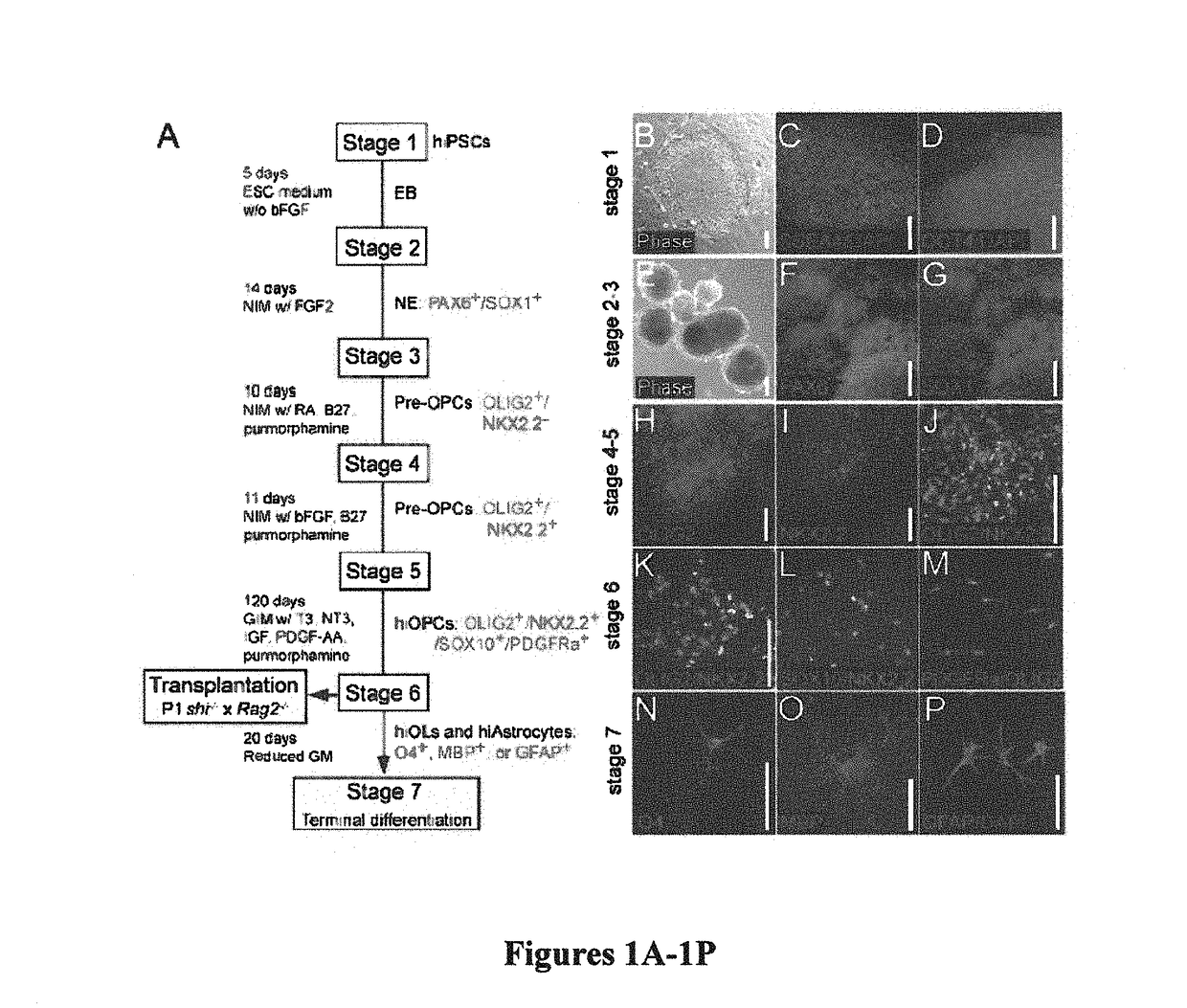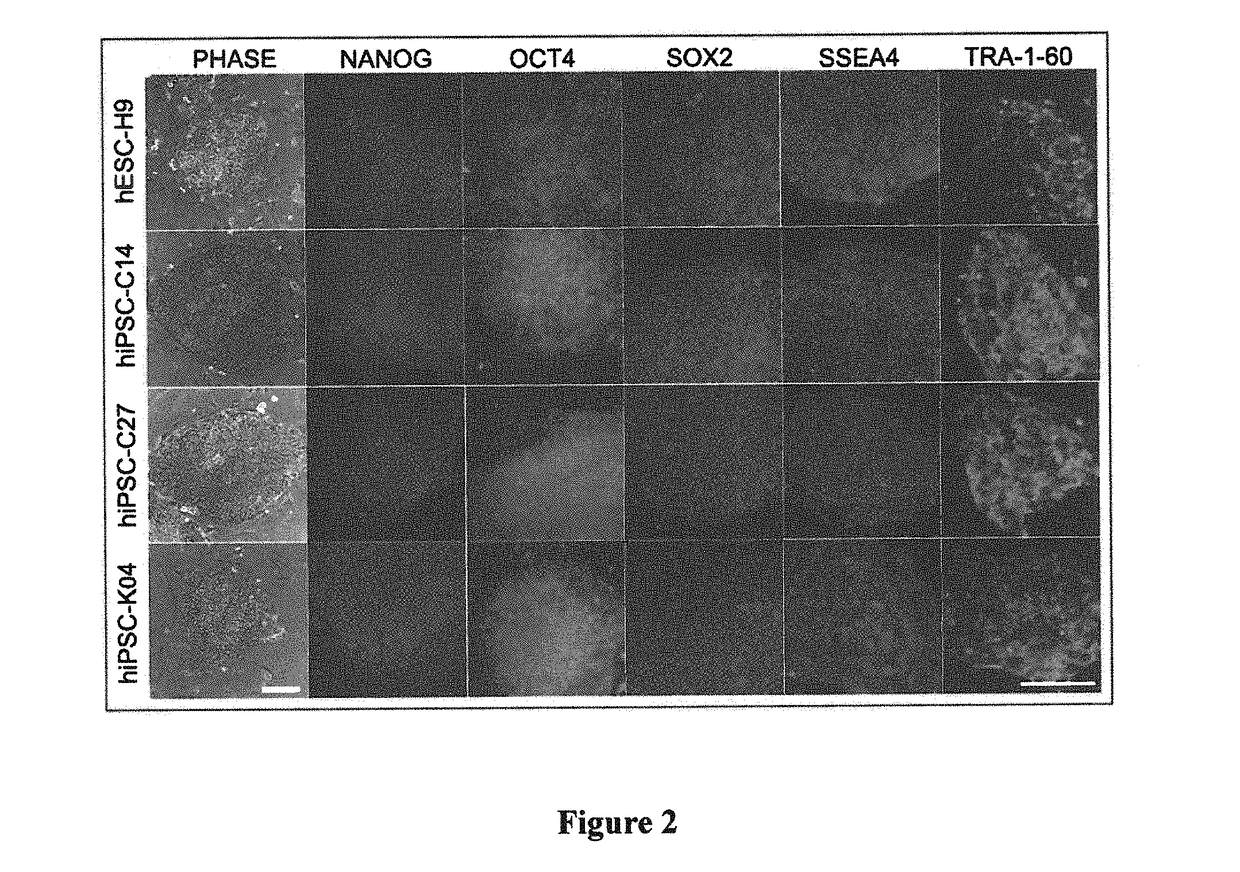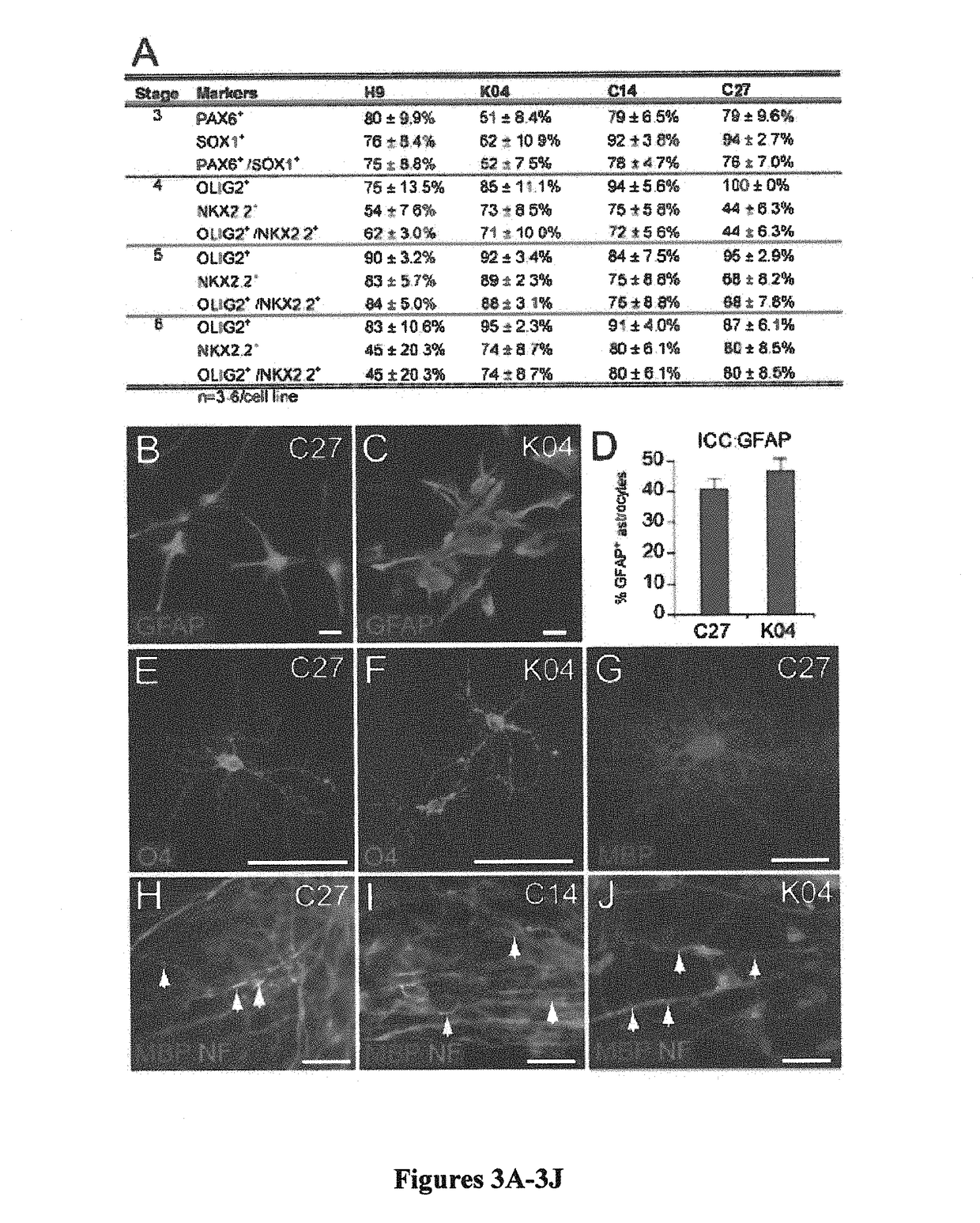Induced pluripotent cell-derived oligodendrocyte progenitor cells for the treatment of myelin disorders
a technology of oligodendrocytes and oligodendrocytes, which is applied in the field of preparation of induced pluripotent cell-derived oligodendrocyte progenitor cells, can solve the problems of patchy remyelination, low efficiency, and inability to properly develop or repair myelin, and achieves a robust and reliable protocol
- Summary
- Abstract
- Description
- Claims
- Application Information
AI Technical Summary
Benefits of technology
Problems solved by technology
Method used
Image
Examples
example 1
Cs can be Efficiently Directed to Glial Progenitor Cell Fate
[0109]Four different iPSC lines from three different sources were used for this study; these included WA09 / H9 hESCs (Thomson et al., “Embryonic Stem Cell Lines Derived From Human Blastocysts,”Science 282:1145-1147 (1998), which is hereby incorporated by reference in its entirety); keratinocyte-derived K04 hiPSCs (Maherali et al., “A High-Efficiency System for the Generation and Study of Human Induced Pluripotent Stem Cells,”Cell Stem Cell 3:340-345 (2008), which is hereby incorporated by reference in its entirety); and fibroblast-derived C14 and C27 hiPSCs (Chambers et al., “Highly Efficient Neural Conversion of Human ES and iPS Cells by Dual Inhibition of SMAD Signaling,”Nat. Biotechnol. 27:275-280 (2009), which is hereby incorporated by reference in its entirety). Specific features of several published protocols were selected for the production of glial progenitor cells from hESCs (Hu et al., “Differentiation of Human Oli...
example 2
ocytes and OLs are Efficiently Derived from hiPSC-Derived hOPCs
[0110]Both in vitro and in vivo, hiPSC OPCs readily differentiated into astrocytes as well as OLs. GFAP-defined astroglia first appeared by 70 days in vitro (DIV), significantly earlier than OLs did. By late stage 6, at 120 DIV, GFAP+ astrocytes were found to be abundant when gliogenic spheres were plated onto a polyornithine / laminin-coated surface (FIGS. 3B-3D). By that time, GFAP+ cells comprised 40%-50% of cells in OPC-induced cultures, across all cell lines (FIG. 3D). Quantitative RT-PCR confirmed the upregulation of GFAP messenger RNA (mRNA) expression during OPC differentiation in all cell lines (Table 2).
TABLE 2Astrocytic appearance during OPC induction: qPCR of GFAPhiPSC linesStage InStage 6nC271.0 ± 0.1%415,801.8 ± 7393.7% 4K041.0 ± 0.1%39,623.6 ± 2434.6%5WA09 / H91.0 ± 0.1%55,077.1 ± 3526.9%3% ± SEMHuman iPSC cultures were subjected to quantitative real-time PCR (qPCR) for astrocytic glial fibrillary acidic prote...
example 3
d be Isolated from hiPSC Cultures by CD140a- and CD9-Directed Fluorescence-Activated Cell Sorting
[0112]Flow cytometry for A2B5, CD140a / PDGFaR, and the tetraspanin CD9 (Berry et al., “Cytology and Lineage of NG2-Positive Glia,”J. Neurocytol. 31:457-467 (2002); Terada et al., “The Tetraspanin Protein, CD9, Is Expressed by Progenitor Cells Committed to Oligodendrogenesis and Is Linked to Betal Integrin, CD81, and Tspan-2,” Glia 40:350-359 (2002), which are hereby incorporated by reference in their entirety) was next used for identifying and quantifying hiPSC OPCs in stage 6 culture (FIGS. 5B and 5C). CD140a+ OPCs derived from C27, C14, and K04 hiPSCs respectively comprised 33.0±10.3%, 32.8±12.0%, and 41.1±6.1% of all cells, compared to 37.5±10.2% of H9-derived cells (FIG. 5C; Table 4). The CD9+ fraction of CD140a+ cells, which defined a later-stage pool of OPCs, comprised 24.0±8.0% and 12.4±2.3% of cells in stage 6 C27 and K04 hiPSC cultures, respectively; matched cultures of H9-derive...
PUM
| Property | Measurement | Unit |
|---|---|---|
| time | aaaaa | aaaaa |
| diameter | aaaaa | aaaaa |
| diameters | aaaaa | aaaaa |
Abstract
Description
Claims
Application Information
 Login to View More
Login to View More - R&D
- Intellectual Property
- Life Sciences
- Materials
- Tech Scout
- Unparalleled Data Quality
- Higher Quality Content
- 60% Fewer Hallucinations
Browse by: Latest US Patents, China's latest patents, Technical Efficacy Thesaurus, Application Domain, Technology Topic, Popular Technical Reports.
© 2025 PatSnap. All rights reserved.Legal|Privacy policy|Modern Slavery Act Transparency Statement|Sitemap|About US| Contact US: help@patsnap.com



